An Improved Pansharpening Method for Misaligned Panchromatic and Multispectral Data
Abstract
:1. Introduction
2. Methodologies
2.1. The RMI Method
2.2. The Improved Version of the RMI Method
| Algorithm 1: Improved_RMI |
| input: upsampled MS bands I, PAN band P, band number N |
| output: fused MS bands F |
| Let PL be a PAN band at MS scale, generating from P using an averaging approach |
| Let ai and b are the coefficients generated using (4) by the least-squares approach |
| PS ← |
| Let Hp and Hi be haze values for PAN and the ith MS bands, respectively |
| Let and be haze values for dark pixels |
| ← |
| ← |
| Let E be the union of the edge PAN pixels identified using CANNY, let F be the other pixels no belonging to E |
| Let Fi be the fused ith MS band |
| for each pixel t in E |
| for each band i in [1, 2, …, N] |
| Fi(t) is calculated using (5) |
| end for |
| end for |
| for each pixel t in F |
| Let T be the threshold used to identify dark pixels, determined using T = δP × S |
| for each band i in [1, 2, …, N] |
| if P(t) − Hp ≥ T |
| Fi(t) is calculated using (2) |
| Else |
| Fi(t) is calculated using (6) |
| end if |
| end for |
| end for |
| return F |
3. Experiments
3.1. Test Data
3.2. Comparing with Other Methods
3.2.1. Fusion Methods for Comparison and Evaluation Criteria
3.2.2. Results and Analysis
3.3. Sensitivity to Misalignments between MS and PAN Bands
4. Discussion
5. Conclusions
- (1)
- The improved approach can reduce spectral distortions of fused dark pixels, thus the proposed method is a good choice for producing high-resolution MS images in applications related to water-bodies and shadows.
- (2)
- The improved approach can be used to obtain fused images with sharpened boundaries between different objects, through choosing a reasonable value for k. This is very useful for fused products covering urban regions, and fused products used for local region mapping or image interpretation.
- (3)
- The experiment used to evaluate the sensitivities of these method to misalignments between MS and PAN bands showed that the proposed method is more robust to misalignments between the MS and PAN bands than the other methods. These conclusions indicate that the improved method is very promising to be widely used in practical remote sensing applications.
Acknowledgments
Author Contributions
Conflicts of Interest
References
- Aiazzi, B.; Baronti, S.; Selva, M. Improving component substitution pansharpening through multivariate regression of MS + PAN data. IEEE Trans. Geosci. Remote Sens. 2007, 45, 3230–3239. [Google Scholar] [CrossRef]
- Kim, Y.; Kim, Y. Improved classification accuracy based on the output-level fusion of high-resolution satellite images and airborne LIDAR data in urban area. IEEE Geosci. Remote Sens. Lett. 2014, 11, 636–640. [Google Scholar]
- Yang, J.; Li, P. Impervious surface extraction in urban areas from high spatial resolution imagery using linear spectral unmixing. Remote Sens. Appl. Soc. Environ. 2015, 1, 61–71. [Google Scholar] [CrossRef]
- Liu, W.; Yamazaki, F. Object-based shadow extraction and correction of high-resolution optical satellite images. IEEE J. Sel. Top. Appl. Earth Obs. Remote Sens. 2012, 5, 1296–1302. [Google Scholar] [CrossRef]
- Yu, L.; Wang, J.; Clinton, N.; Xin, Q.; Zhong, L.; Chen, Y.; Gong, P. FROM-GC: 30 m global cropland extent derived through multisource data integration. Int. J. Digit. Earth 2013, 6, 521–533. [Google Scholar] [CrossRef]
- Ashraf, S.; Brabyn, L.; Hicks, B.J. Image data fusion for the remote sensing of freshwater environments. Appl. Geogr. 2012, 32, 619–628. [Google Scholar] [CrossRef]
- Jawak, S.D.; Luis, A.J. A spectral index ratio-based antarctic land-cover mapping using hyperspatial 8-band worldview-2 imagery. Polar Sci. 2013, 7, 18–38. [Google Scholar] [CrossRef]
- Rokni, K.; Ahmad, A.; Solaimani, K.; Hazini, S. A new approach for surface water change detection: Integration of pixel level image fusion and image classification techniques. Int. J. Appl. Earth Obs. Geoinf. 2015, 34, 226–234. [Google Scholar] [CrossRef]
- Adeline, K.R.M.; Chen, M.; Briottet, X.; Pang, S.K.; Paparoditis, N. Shadow detection in very high spatial resolution aerial images: A comparative study. ISPRS J. Photogramm. Remote Sens. 2013, 80, 21–38. [Google Scholar] [CrossRef]
- Pohl, C.; Van Genderen, J.L. Review article multisensor image fusion in remote sensing: Concepts, methods and applications. Int. J. Remote Sens. 1998, 19, 823–854. [Google Scholar] [CrossRef]
- Vivone, G.; Alparone, L.; Chanussot, J.; Dalla Mura, M.; Garzelli, A.; Licciardi, G.A.; Restaino, R.; Wald, L. A critical comparison among pansharpening algorithms. IEEE Trans. Geosci. Remote Sens. 2015, 33, 2565–2586. [Google Scholar] [CrossRef]
- Thomas, C.; Ranchin, T.; Wald, L.; Chanussot, J. Synthesis of multispectral images to high spatial resolution: A critical review of fusion methods based on remote sensing physics. IEEE Trans. Geosci. Remote Sens. 2008, 46, 1301–1312. [Google Scholar] [CrossRef] [Green Version]
- Xu, Q.; Zhang, Y.; Li, B. Recent advances in pansharpening and key problems in applications. Int. J. Image Data Fusion 2014, 5, 175–195. [Google Scholar] [CrossRef]
- Lang, J.; Hao, Z. Novel image fusion method based on adaptive pulse coupled neural network and discrete multi-parameter fractional random transform. Opt. Lasers Eng. 2014, 52, 91–98. [Google Scholar] [CrossRef]
- Pohl, C.; van Genderen, J. Structuring contemporary remote sensing image fusion. Int. J. Image Data Fusion 2015, 6, 3–21. [Google Scholar] [CrossRef]
- Li, S.; Kang, X.; Fang, L.; Hu, J.; Yin, H. Pixel-level image fusion: A survey of the state of the art. Inf. Fusion 2017, 33, 100–112. [Google Scholar] [CrossRef]
- Zhang, J. Multi-source remote sensing data fusion: Status and trends. Int. J. Image Data Fusion 2010, 1, 5–24. [Google Scholar] [CrossRef]
- Jing, L.; Cheng, Q. An image fusion method for misaligned panchromatic and multispectral data. Int. J. Remote Sens. 2011, 32, 1125–1137. [Google Scholar] [CrossRef]
- Choi, J.; Yu, K.; Kim, Y. A new adaptive component-substitution-based satellite image fusion by using partial replacement. IEEE Trans. Geosci. Remote Sens. 2011, 49, 295–309. [Google Scholar] [CrossRef]
- Dong, W.; Li, X.E.; Lin, X.; Li, Z. A bidimensional empirical mode decomposition method for fusion of multispectral and panchromatic remote sensing images. Remote Sens. 2014, 6, 8446–8467. [Google Scholar] [CrossRef]
- Alparone, L.; Wald, L.; Chanussot, J.; Thomas, C.; Gamba, P.; Bruce, L.M. Comparison of pansharpening algorithms: Outcome of the 2006 GRS-S data-fusion contest. IEEE Trans. Geosci. Remote Sens. 2007, 45, 3012–3021. [Google Scholar] [CrossRef] [Green Version]
- Aiazzi, B.; Alparone, L.; Baronti, S.; Garzelli, A. Context-driven fusion of high spatial and spectral resolution images based on oversampled multiresolution analysis. IEEE Trans. Geosci. Remote Sens. 2002, 40, 2300–2312. [Google Scholar] [CrossRef]
- Peleg, S.; Rousso, B.; Rav-Acha, A.; Zomet, A. Mosaicing on adaptive manifolds. IEEE Trans. Pattern Anal. Mach. Intell. 2000, 22, 1144–1154. [Google Scholar] [CrossRef]
- Brown, M.; Lowe, D.G. Automatic panoramic image stitching using invariant features. Int. J. Comput. Vis. 2007, 74, 59–73. [Google Scholar] [CrossRef]
- Feng, H.; Tuotuo, L.; Zheng, G. Constraints-based graph embedding optimal surveillance-video mosaicking. In Proceedings of the First Asian Conference on Pattern Recognition, Beijing, China, 28 November 2011; pp. 311–315. [Google Scholar]
- Kupfer, B.; Netanyahu, N.S.; Shimshoni, I. An efficient sift-based mode-seeking algorithm for sub-pixel registration of remotely sensed images. IEEE Geosci. Remote Sens. Lett. 2015, 12, 379–383. [Google Scholar] [CrossRef]
- Ye, Y.; Shan, J.; Bruzzone, L.; Shen, L. Robust registration of multimodal remote sensing images based on structural similarity. IEEE Trans. Geosci. Remote Sens. 2017, 55, 2941–2958. [Google Scholar] [CrossRef]
- Blanc, P.; Wald, L.; Ranchin, T. Importance and effect of co-registration quality in an example of “pixel to pixel” fusion process. In Proceedings of the 2nd International Conference on Fusion of Earth Data: Merging Point Measures, Raster Maps Remotely Sensed Images, Sophia Antipolis, France, 28–30 January 1998; SEE/URISCA: Nice, France, 1998; pp. 67–74. [Google Scholar]
- Baronti, S.; Aiazzi, B.; Selva, M.; Garzelli, A.; Alparone, L. A theoretical analysis of the effects of aliasing and misregistration on pansharpened imagery. IEEE J. Sel. Top. Signal Process. 2011, 5, 446–453. [Google Scholar] [CrossRef]
- Jing, L.; Cheng, Q.; Guo, H.; Lin, Q. Image misalignment caused by decimation in image fusion evaluation. Int. J. Remote Sens. 2012, 33, 4967–4981. [Google Scholar] [CrossRef]
- Hallabia, H.; Kallel, A.; Hamida, A.B.; Hégarat-Mascle, S.L. High spectral quality pansharpening approach based on MTF-matched filter banks. Multidimens. Syst. Signal Process. 2016, 27, 831–861. [Google Scholar] [CrossRef]
- Jing, L.; Cheng, Q. Two improvement schemes of pan modulation fusion methods for spectral distortion minimization. Int. J. Remote Sens. 2009, 30, 2119–2131. [Google Scholar] [CrossRef]
- Laben, C.A.; Brower, B.V. Process for Enhancing the Spatial Resolution of Multispectral Imagery Using Pan-Sharpening. U.S. Patent 6,011,875, 4 January 2000. [Google Scholar]
- Aiazzi, B.; Alparone, L.; Baronti, S.; Garzelli, A. MTF-tailored multiscale fusion of high-resolution MS and Pan imagery. Photogramm. Eng. Remote Sens. 2006, 72, 591–596. [Google Scholar] [CrossRef]
- Ranchin, T.; Wald, L. Fusion of high spatial and spectral resolution images: The ARSIS concept and its implementation. Photogramm. Eng. Remote Sens. 2000, 66, 49–61. [Google Scholar]
- Wald, L. Quality of high resolution synthesised images: Is there a simple criterion? In Proceedings of the 3rd Conference on Fusion of Earth Data: Merging Point Measurements, Raster Maps and Remotely Sensed Images, Sophia Antipolis, France, 26–28 January 2000; SEE/URISCA: Nice, France, 2000; pp. 99–103. [Google Scholar]
- Yuhas, R.; Goetz, A.; Boardman, J. Discrimination among semi-arid landscape endmembers using the spectral angle mapper (SAM) algorithm. In Summaries of the Third Annual JPL Airborne Geoscience Workshop; Jet Propulsion Laboratory: Pasadena, CA, USA, 1992; pp. 147–149. [Google Scholar]
- Wang, Z.; Bovik, A.C. A universal image quality index. IEEE Signal Process. Lett. 2002, 9, 81–84. [Google Scholar] [CrossRef]
- Alparone, L.; Baronti, S.; Garzelli, A.; Nencini, F. A global quality measurement of pan-sharpened multispectral imagery. IEEE Geosci. Remote Sens. Lett. 2004, 1, 313–317. [Google Scholar] [CrossRef]
- Garzelli, A.; Nencini, F. Hypercomplex quality assessment of multi/hyperspectral images. IEEE Geosci. Remote Sens. Lett. 2009, 6, 662–665. [Google Scholar] [CrossRef]
- Otazu, X.; Gonzalez-Audicana, M.; Fors, O.; Nunez, J. Introduction of sensor spectral response into image fusion methods: Application to wavelet-based methods. IEEE Trans. Geosci. Remote Sens. 2005, 43, 2376–2385. [Google Scholar] [CrossRef] [Green Version]
- Alparone, L.; Alazzi, B.; Baronti, S.; Garzelli, A.; Nencini, F.; Selva, M. Multispectral and panchromatic data fusion assessment without reference. Photogramm. Eng. Remote Sens. 2008, 74, 193–200. [Google Scholar] [CrossRef]
- Li, H.; Jing, L. Improvement of a pansharpening method taking into account haze. IEEE J. Sel. Top. Appl. Earth Obs. Remote Sens. 2017, 10, 5039–5055. [Google Scholar] [CrossRef]
- Jing, L.; Cheng, Q. Spectral change directions of multispectral subpixels in image fusion. Int. J. Remote Sens. 2011, 32, 1695–1711. [Google Scholar] [CrossRef]
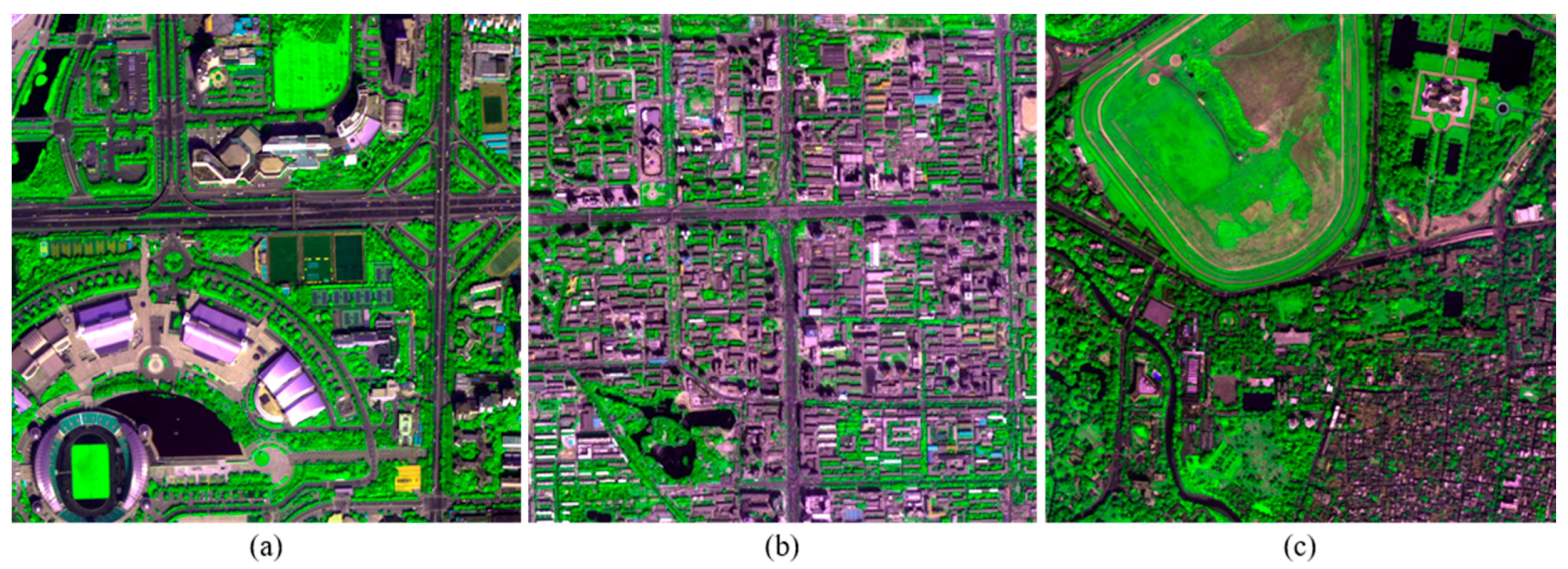

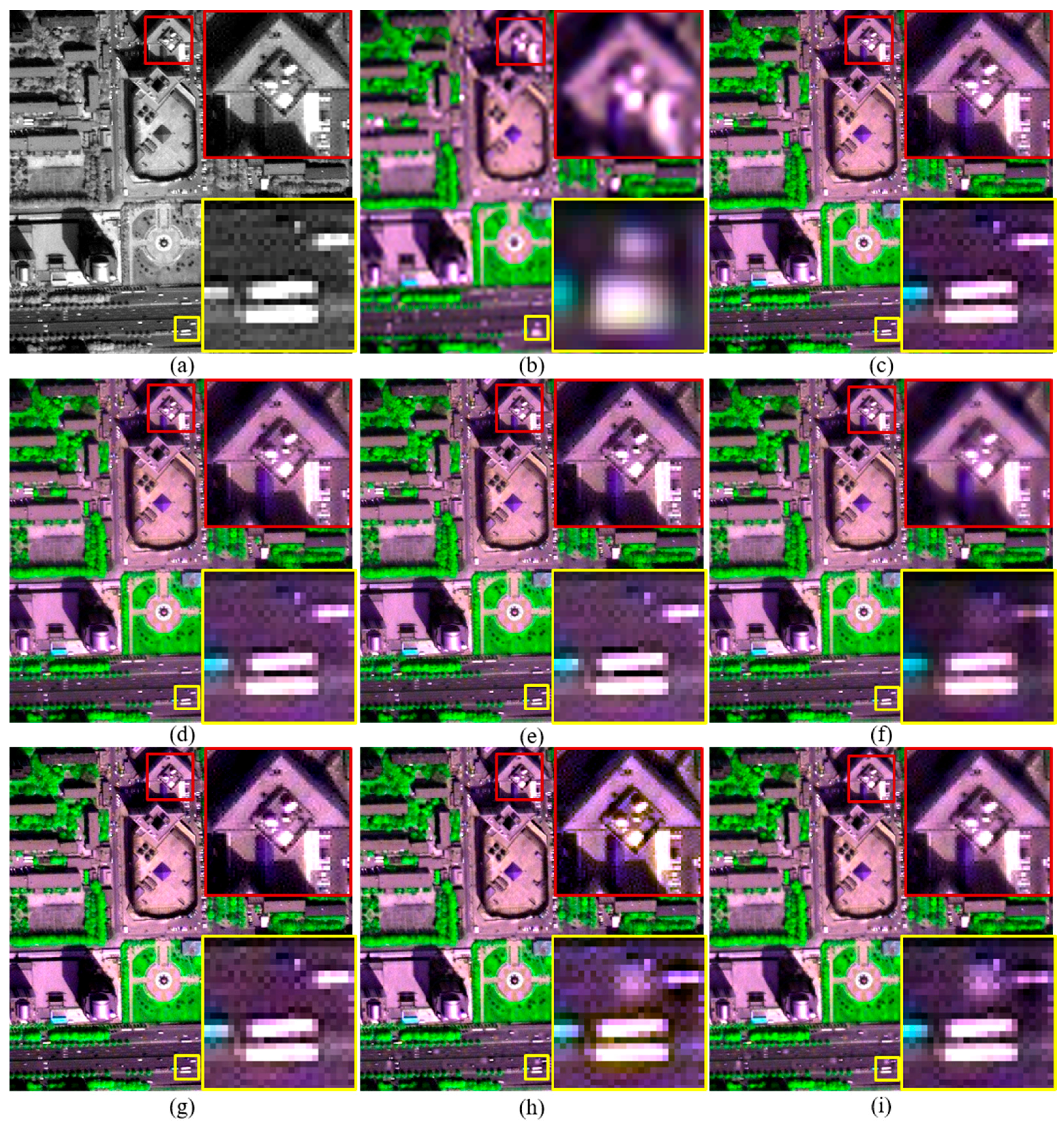
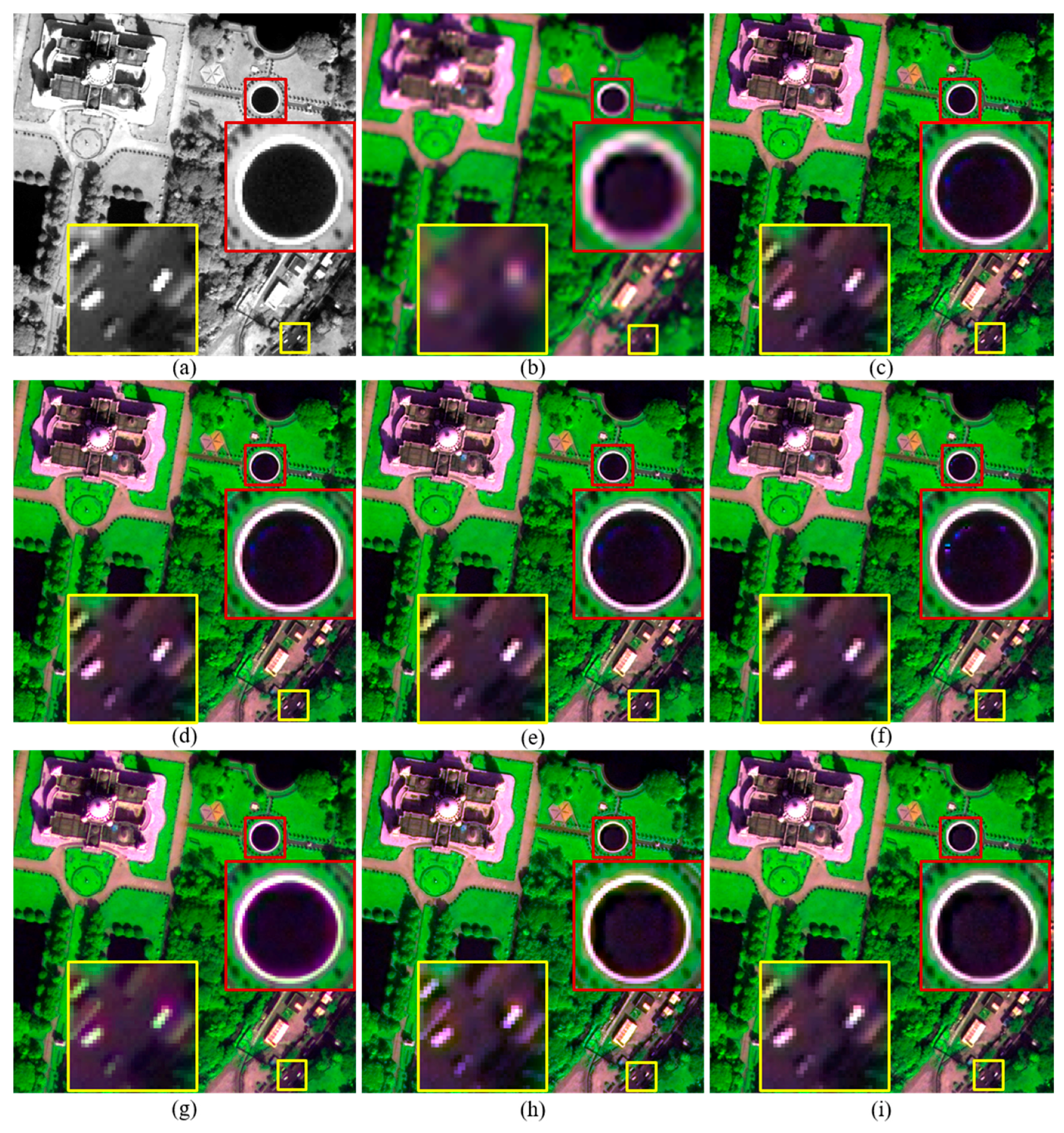
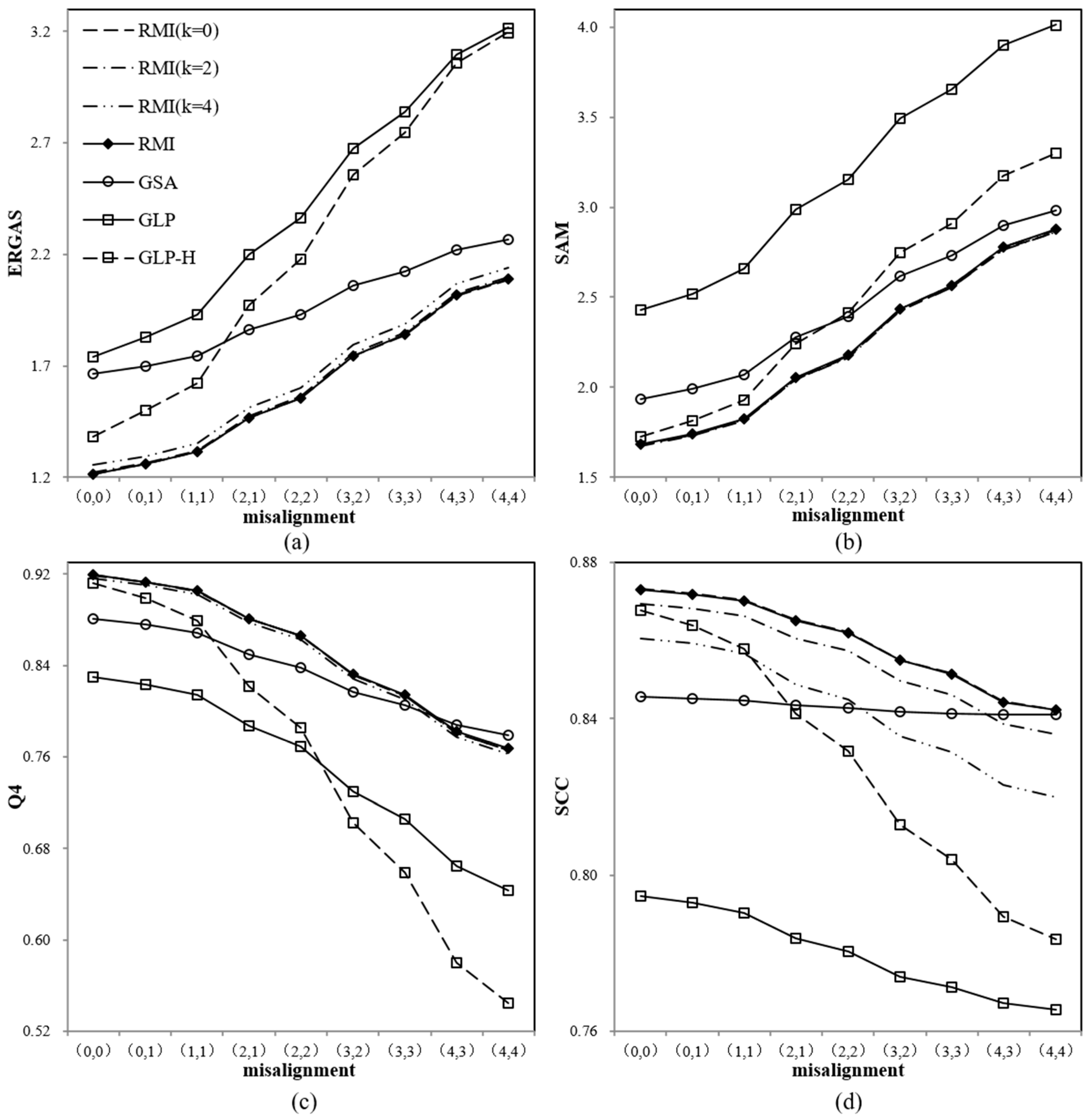
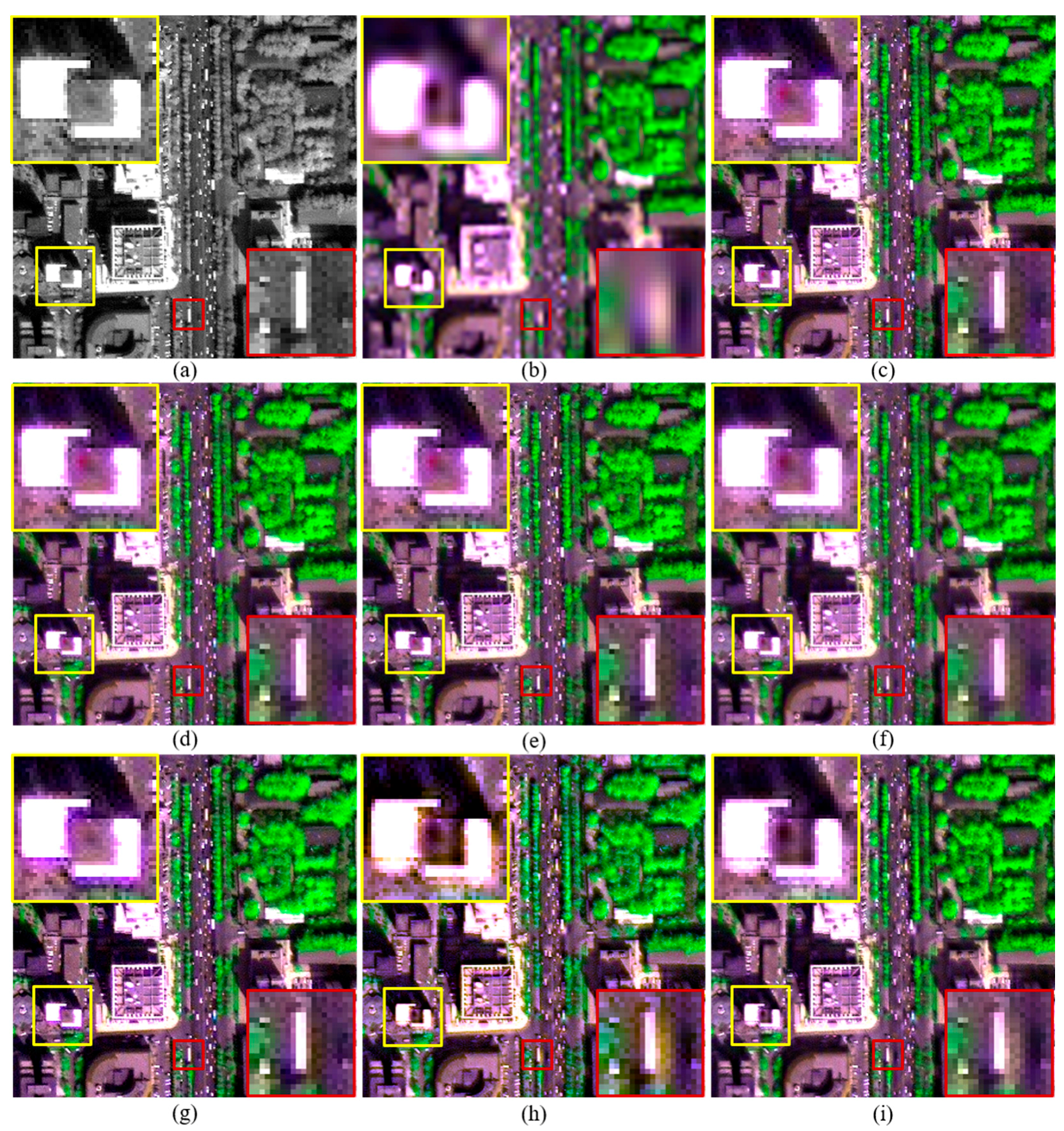
| Image | Method | Degraded Scale | Original Scale | |||||||
|---|---|---|---|---|---|---|---|---|---|---|
| RASE | ERGAS | SAM | Q2n | SCC | SAMd | Dλ | DS | QNR | ||
| WV2 | RMI (k = 0) | 6.67 | 1.740 | 2.28 | 0.9360 | 0.845 | 1.127 | 0.0600 | 0.067 | 0.877 |
| RMI (k = 1) | 6.72 | 1.75 | 2.28 | 0.935 | 0.843 | 1.127 | 0.061 | 0.068 | 0.876 | |
| RMI (k = 2) | 6.80 | 1.77 | 2.29 | 0.934 | 0.840 | 1.127 | 0.062 | 0.068 | 0.875 | |
| RMI (k = 3) | 6.92 | 1.80 | 2.30 | 0.933 | 0.836 | 1.126 | 0.062 | 0.068 | 0.874 | |
| RMI (k = 4) | 7.05 | 1.84 | 2.31 | 0.931 | 0.830 | 1.126 | 0.063 | 0.068 | 0.873 | |
| RMI | 6.68 | 1.745 | 2.28 | 0.9357 | 0.844 | 1.148 | 0.0600 | 0.068 | 0.876 | |
| GSA | 7.60 | 1.98 | 2.69 | 0.913 | 0.824 | 2.204 | 0.074 | 0.089 | 0.844 | |
| GLP | 8.05 | 2.06 | 2.94 | 0.845 | 0.807 | 1.263 | 0.113 | 0.110 | 0.789 | |
| GLP-H | 7.48 | 1.95 | 2.36 | 0.932 | 0.843 | 1.094 | 0.066 | 0.066 | 0.872 | |
| EXP | 12.61 | 3.26 | 2.94 | 0.791 | 0.441 | 1.263 | 0.000 | 0.068 | 0.932 | |
| IK | RMI (k = 0) | 4.63 | 1.214 | 1.677 | 0.9192 | 0.8734 | 0.577 | 0.0556 | 0.0919 | 0.8576 |
| RMI (k = 1) | 4.65 | 1.22 | 1.67 | 0.919 | 0.872 | 0.577 | 0.057 | 0.093 | 0.855 | |
| RMI (k = 2) | 4.70 | 1.23 | 1.67 | 0.918 | 0.868 | 0.577 | 0.058 | 0.094 | 0.853 | |
| RMI (k = 3) | 4.79 | 1.25 | 1.68 | 0.916 | 0.863 | 0.577 | 0.060 | 0.095 | 0.850 | |
| RMI (k = 4) | 4.90 | 1.28 | 1.68 | 0.914 | 0.857 | 0.577 | 0.062 | 0.096 | 0.849 | |
| RMI | 4.64 | 1.214 | 1.677 | 0.9193 | 0.8734 | 0.712 | 0.0556 | 0.0919 | 0.8576 | |
| GSA | 6.38 | 1.66 | 1.93 | 0.880 | 0.846 | 2.239 | 0.097 | 0.143 | 0.774 | |
| GLP | 6.94 | 1.74 | 2.43 | 0.830 | 0.795 | 0.563 | 0.167 | 0.169 | 0.692 | |
| GLP-H | 5.29 | 1.38 | 1.72 | 0.912 | 0.868 | 0.574 | 0.068 | 0.091 | 0.847 | |
| EXP | 9.63 | 2.52 | 2.42 | 0.661 | 0.453 | 0.567 | 0.000 | 0.099 | 0.901 | |
| QB | RMI (k = 0) | 5.65 | 1.398 | 1.877 | 0.892 | 0.837 | 0.717 | 0.086 | 0.115 | 0.809 |
| RMI (k = 1) | 5.81 | 1.43 | 1.90 | 0.889 | 0.833 | 0.717 | 0.087 | 0.116 | 0.807 | |
| RMI (k = 2) | 6.02 | 1.48 | 1.93 | 0.886 | 0.828 | 0.717 | 0.088 | 0.117 | 0.805 | |
| RMI (k = 3) | 6.26 | 1.53 | 1.97 | 0.881 | 0.822 | 0.717 | 0.090 | 0.117 | 0.803 | |
| RMI (k = 4) | 6.54 | 1.60 | 2.00 | 0.877 | 0.814 | 0.716 | 0.091 | 0.118 | 0.802 | |
| RMI | 5.66 | 1.401 | 1.879 | 0.890 | 0.836 | 0.945 | 0.087 | 0.114 | 0.809 | |
| GSA | 7.22 | 1.73 | 2.53 | 0.877 | 0.797 | 2.871 | 0.045 | 0.086 | 0.872 | |
| GLP | 8.42 | 2.08 | 2.88 | 0.701 | 0.715 | 0.737 | 0.172 | 0.209 | 0.655 | |
| GLP-H | 6.34 | 1.54 | 1.99 | 0.888 | 0.832 | 0.725 | 0.079 | 0.102 | 0.827 | |
| EXP | 9.97 | 2.37 | 2.97 | 0.743 | 0.487 | 0.717 | 0.000 | 0.088 | 0.912 | |
| Image | Method | Degraded Scale | |||||
|---|---|---|---|---|---|---|---|
| RASE | ERGAS | SAM | Q2n | SCC | SAMd | ||
| QB | RMI (k = 0) | 5.651 | 1.398 | 1.877 | 0.891 | 0.837 | 0.7138 |
| RMI (k = 1) | 5.812 | 1.434 | 1.900 | 0.889 | 0.833 | 0.7138 | |
| RMI (k = 2) | 6.017 | 1.480 | 1.930 | 0.885 | 0.828 | 0.7138 | |
| RMI (k = 3) | 6.261 | 1.534 | 1.965 | 0.881 | 0.822 | 0.7138 | |
| RMI (k = 4) | 6.541 | 1.597 | 2.005 | 0.877 | 0.814 | 0.7138 | |
| RMI (k = 5) | 6.851 | 1.667 | 2.047 | 0.871 | 0.805 | 0.7137 | |
| RMI (k = 6) | 7.187 | 1.743 | 2.093 | 0.865 | 0.795 | 0.7137 | |
| RMI (k = 7) | 7.547 | 1.824 | 2.140 | 0.859 | 0.785 | 0.7137 | |
| RMI (k = 8) | 7.926 | 1.910 | 2.190 | 0.852 | 0.774 | 0.7137 | |
| RMI (k = 9) | 8.321 | 2.001 | 2.241 | 0.845 | 0.764 | 0.7136 | |
| RMI (k = 10) | 8.731 | 2.094 | 2.294 | 0.837 | 0.753 | 0.7136 | |
| Image | S | Degraded Scale | ||||
|---|---|---|---|---|---|---|
| RASE | ERGAS | SAM | Q2n | SCC | ||
| QB | 0.1 | 5.652 | 1.399 | 1.877 | 0.891 | 0.837 |
| 0.2 | 5.651 | 1.398 | 1.877 | 0.892 | 0.837 | |
| 0.3 | 5.651 | 1.398 | 1.877 | 0.891 | 0.837 | |
| 0.4 | 5.652 | 1.399 | 1.878 | 0.891 | 0.837 | |
| 0.5 | 5.654 | 1.399 | 1.879 | 0.891 | 0.836 | |
| 0.6 | 5.658 | 1.400 | 1.883 | 0.890 | 0.836 | |
| 0.7 | 5.665 | 1.402 | 1.888 | 0.889 | 0.836 | |
| 0.8 | 5.676 | 1.404 | 1.895 | 0.887 | 0.836 | |
| 0.9 | 5.693 | 1.409 | 1.905 | 0.885 | 0.835 | |
| 1 | 5.718 | 1.415 | 1.917 | 0.881 | 0.834 | |
© 2018 by the authors. Licensee MDPI, Basel, Switzerland. This article is an open access article distributed under the terms and conditions of the Creative Commons Attribution (CC BY) license (http://creativecommons.org/licenses/by/4.0/).
Share and Cite
Li, H.; Jing, L.; Tang, Y.; Ding, H. An Improved Pansharpening Method for Misaligned Panchromatic and Multispectral Data. Sensors 2018, 18, 557. https://doi.org/10.3390/s18020557
Li H, Jing L, Tang Y, Ding H. An Improved Pansharpening Method for Misaligned Panchromatic and Multispectral Data. Sensors. 2018; 18(2):557. https://doi.org/10.3390/s18020557
Chicago/Turabian StyleLi, Hui, Linhai Jing, Yunwei Tang, and Haifeng Ding. 2018. "An Improved Pansharpening Method for Misaligned Panchromatic and Multispectral Data" Sensors 18, no. 2: 557. https://doi.org/10.3390/s18020557





